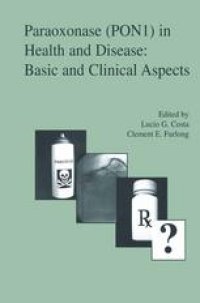
Ebook: Paraoxonase (PON1) in Health and Disease: Basic and Clinical Aspects
- Tags: Ecotoxicology, Pharmacology/Toxicology, Cardiology, Public Health
- Year: 2002
- Publisher: Springer US
- Edition: 1
- Language: English
- pdf
The paraoxonase or PON family of genes resides on human chromosome 7q2t-22 in the order PONt, PON3 and PON2. PONt was one of the early genes identified as an environmentally relevant gene, in that it is important in determining an individual's sensitivity or resistance to exposure from specific organophosphorus (OP) insecticides. Paraoxonase (PONt) is an A esterase (i. e. , not inhibited by OP compounds) initially identified for its ability to catalytically hydrolyze paraoxon, the toxic metabolite (oxon form) of the insecticide parathion. Evidence accumulated in the past several years has established that this enzyme, which is present at variable levels in liver and serum of different individuals, is an important determinant of sensitivity to toxicity of specific organophosphorus compounds including chlorpyrifos oxon and diazoxon. Recent experiments have pointed out that it is the catalytic efficiency of PONt together with the levels of PONt that are important in determining the degree of resistance. Surprisingly, even though PONt has a higher catalytic efficiency than PONtQ)92 for paraoxon RJ92 hydrolysis, it does not provide significant in vivo protection against an exposure to paraoxon. Interest in this enzyme has also emerged from the finding that it displays genetic polymorphisms in most populations, with a significant number of the individuals in a given population canying a PONt gene that puts them at risk for a specific OP exposure.
The journey to find genes responsible for determining sensitivity or resistance to specific insecticides led to the paraoxonase (PON1) gene on human chromosome 7. This gene encodes a 355 amino acid protein that is localized on the high density lipoprotein (HDL) particles in plasma. Characterization of this gene revealed that different individuals expressed both different forms of this enzyme with amino acid substitutions at positions 55 and 192 as well as different levels of this protein. Additional studies showed that mutations in the regulatory region of the PON1 gene contributed to the very different levels of plasma PON1 among individuals. It turned out that both the level of the enzyme as well as the amino acid present at position 192 (glutamine or arginine) are important in determining resistance to the active forms of specific organophosphorus insecticides, especially diazinon and chlorpyrifos. The position 192 amino acid also determined whether an individual's plasma hydrolyzed the nerve agents soman and sarin at high or low rates. It is not yet known whether these different rates of hydrolysis observed in biochemical assays reflect differences in sensitivity of individuals to nerve agents. Taken together, all of the experiments carried out to date indicate that engineered recombinant PON1 is an excellent candidate to use for treating cases of poisoning by specific organophosphorus compounds. The available data on the relationship of PON1 levels and position 192 genotype led us to introduce the term PON1 status to describe an individual's PON1 plasma level as well as their position 192 genotype.
The characterization of the genetic variations of the PON1 gene together with experiments showing that HDL can protect the lipids in low density lipoprotein particles (LDL) from oxidation and that it was PON1 that was responsible for this protection have opened an entirely new area of investigation, the role of PON1 in protecting against vascular disease.
More recent reports have noted that PON1 also metabolizes a number of drugs, activating some and inactivating others.
It is the purpose of this book to describe the recent advances in understanding the role of PON1 in both cardiovascular disease and toxicology of insecticide exposure as well as describe some of the recent information indicating an important possible role in the pharmacokinetics of drug metabolism. The final chapter of the book provides an overview of the areas of PON1 research and suggests future directions for research on PON1 as well as the related, linked genes PON2 and PON3.